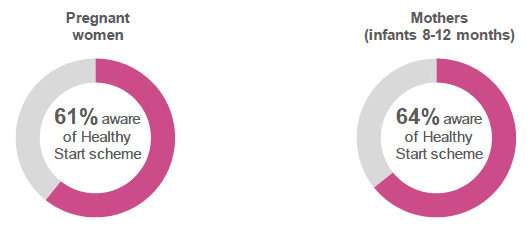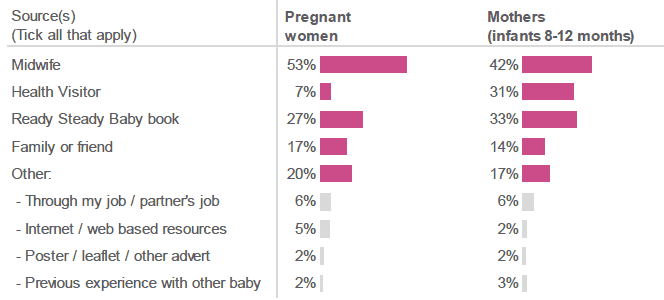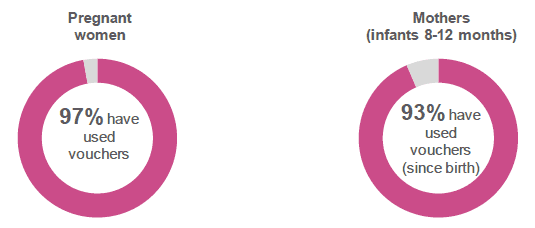Scottish maternal and infant nutrition survey 2017
Results from the 2017 Scottish Maternal and Infant Nutrition Survey. This first Scotland-only survey gathered data on maternal nutrition and infant feeding.
8. The Healthy Start Scheme
The Healthy Start scheme ( R35) is a UK-wide government initiative that aims to help and encourage low income families to eat a healthier diet. Introduced across the UK in 2006, the scheme provides families with vouchers that can be put towards the cost of cows' milk, plain fresh or frozen fruit and vegetables, and infant formula. Vouchers can be used in a wide variety of registered retailers, including supermarkets and pharmacies.
The scheme is open to women who are at least ten weeks pregnant and families with children under the age of four if they are in receipt of certain benefits. Pregnant women under the age of 18 also qualify during the whole of their pregnancy, even if they do not receive benefits.
The following section of this report provides information about awareness of the Healthy Start Scheme and the use of Healthy Start vouchers, as reported by women who responded to the antenatal and 8-12 month survey. Note that a small number of antenatal survey respondents had already given birth when they completed the questionnaire (weighted = 58; unweighted = 62). These respondents have been excluded from the antenatal analysis within this section.
Respondents 8-12 month survey were also asked about their awareness and receipt of the Sure Start Maternity Grant. ( R36) These results are available in the tables that accompany this report (Tables 8.6 – 8.9).
8.1 Awareness of the Healthy Start Scheme
Overall, less than two-thirds of antenatal / 8-12 month survey respondents were aware of the Healthy Start Scheme (61% and 64% respectively).
- Amongst antenatal respondents, those who had previously been pregnant were more frequently aware of the scheme (67%) than those who were in their first pregnancy (55%).
- Similarly, amongst 8-12 month survey respondents, those who already had children were more often aware of the scheme (67%) than those who did not (62%).
[Figure 8.1; Table 8.1a & 8.1b]
Less than two-thirds of survey respondents were aware of Healthy Start Scheme.
Figure 8.1: Were you aware of the Healthy Start scheme before reading the description in this survey? (Percentage of respondents who indicated that they were aware of the scheme. Excludes antenatal respondents who had already given birth).

Source: Q34, Antenatal Survey
Q40, 8-12 Month Survey
In the 2010 UK-wide Infant Feeding Survey ( IFS), only women who thought they were eligible for the scheme, but who had not registered for the scheme, were asked if they were aware of the scheme. ( R7) Therefore results not directly comparable.
Sources of awareness
Most women found out about the scheme through their Midwife / Health Visitor; 60% of antenatal respondents and 74% of postnatal respondents. The NHS Health Scotland publication, Ready Steady Baby, was also frequently indicated as a source by respondents to both surveys (antenatal 27%; 33% postnatal).
[Figure 8.2; Table 8.2a & 8.2b]
Most women found out about the Healthy Start scheme through their Midwife or Health Visitor.
Figure 8.2: How did you find out about the Healthy Start scheme? (Percentage of respondents who selected each source. Respondents who were aware of the scheme (excludes antenatal respondents who had already given birth)).

Source: Q35, Antenatal Survey
Q41, 8-12 Month Survey
In the 2010 IFS only mothers who were eligible for the scheme were asked how they found out about it, therefore results are not directly comparable to the current survey. However, in the 2010 survey, respondents were also most likely to have found out through their Midwife or Health Visitor. ( R7)
8.2 Eligibility for the Healthy Start scheme
A similar proportion of antenatal and postnatal respondents thought that they qualified for the scheme:
- Amongst antenatal respondents, 15% of women thought that they qualified, however only 5% reported that they were already receiving vouchers.
- Amongst 8-12 month survey respondents, 13% thought that they qualified, with 6% already receiving vouchers.
[Figure 8.3; Table 8.3a & 8.3b]
More than one in ten respondents thought that they qualified for the Healthy Start scheme.
Figure 8.3: Do you think that you qualify for the Healthy Start scheme? (Percentage of respondents who selected each category. Excludes antenatal respondents who had already given birth).

Source: Q36, Antenatal Survey
Q42, 8-12 Month Survey
- Just under 10% of women who were unaware of the scheme thought that they qualified, but hadn't applied (7% antenatal / 9% postnatal).
- Around one in ten respondents who were unaware of the Health Start Scheme did not know whether they qualified for the scheme or not (antenatal 10%; postnatal 12%).
[Table 8.3a & & 8.3b]
Age of respondent
Younger mothers were more likely to think that they qualified for the scheme and to be in receipt of Health Start vouchers than older mothers.
Amongst antenatal respondents:
- 33% of those aged 20-24 thought that they qualified for the scheme, but only 9% were currently receiving vouchers.
- By comparison, only 7% of respondents age 35 or over thought that they qualified for the scheme; 3% were currently receiving vouchers.
Amongst postnatal respondents:
- 43% of those aged 20-24 thought that they qualified for the scheme and 20% were currently receiving vouchers.
- Again, only 7% of respondents age 35 or over thought that they qualified for the scheme; 3% were currently receiving vouchers.
[Table A1: Antenatal – Results by Age of Respondent & C1: 8-12 Months – Results by Age of Respondent]
Deprivation
There was also some variation by deprivation amongst antenatal respondents:
- 30% of those living in the most deprived areas ( SIMD 1) thought that they qualified for the scheme, but only 10% were currently receiving vouchers.
- By comparison, only 4% of respondents living in the least deprived areas ( SIMD 5) thought that they qualified for the scheme; 1% were currently receiving vouchers.
This was also the case amongst postnatal respondents:
- 26% of those living in the most deprived areas ( SIMD 1) thought that they qualified for the scheme and 15% were currently receiving vouchers.
- Only 5% of respondents living in the least deprived areas ( SIMD 5) thought that they qualified for the scheme; 1% were currently receiving vouchers.
[Table A2: Antenatal – Results by SIMD & C2: 8-12 Months – Results by SIMD]
8.3 Use of Healthy Start vouchers
The vast majority of antenatal respondents who had received Health Start vouchers had used them (97%). This was also the case for postnatal respondents, where 93% reported that they had used the vouchers since the birth of their baby.
[Figure 8.4; Table 8.4a & 8.4b]
The overwhelming majority of women who had received Healthy Start vouchers had used them.
Figure 8.4: Have you used your Healthy Start vouchers? / Since the birth of your baby, have you used your Healthy Start vouchers? (Percentage of respondents who indicated that they had used the vouchers. All respondents who had received vouchers (excluding antenatal respondents who had already given birth)).

Source: Q37, Antenatal Survey
Q43, 8-12 Month Survey
Only a handful of respondents to each survey indicated that they had not used their vouchers, so no further analysis of this had been presented in this report.
Items purchased with vouchers
Amongst antenatal respondents, the majority used their vouchers to buy cows' milk (80%), fruit (88%) or vegetables (74%). More than a quarter of these respondents (28%) reported using the vouchers to buy infant formula.
Amongst respondents to the 8-12 month survey, vouchers were also frequently used to buy fruit or vegetables (65% and 66% respectively), but higher proportion of respondent (83%) reported using the vouchers to buy infant formula.
[Figure 8.5; Table 8.5a & 8.5b]
All respondents frequently used Healthy Start vouchers to buy fruit and vegetables, but antenatal women often bought cows' milk and postnatal respondents often purchased infant formula.
Figure 8.5: What did you buy with your Healthy Start vouchers? (Percentage of respondents who indicated that they had purchased each item. All respondents who had used vouchers (excluding antenatal respondents who had already given birth)).

Source: Q38, Antenatal Survey
Q44, 8-12 Month Survey
Contact
There is a problem
Thanks for your feedback